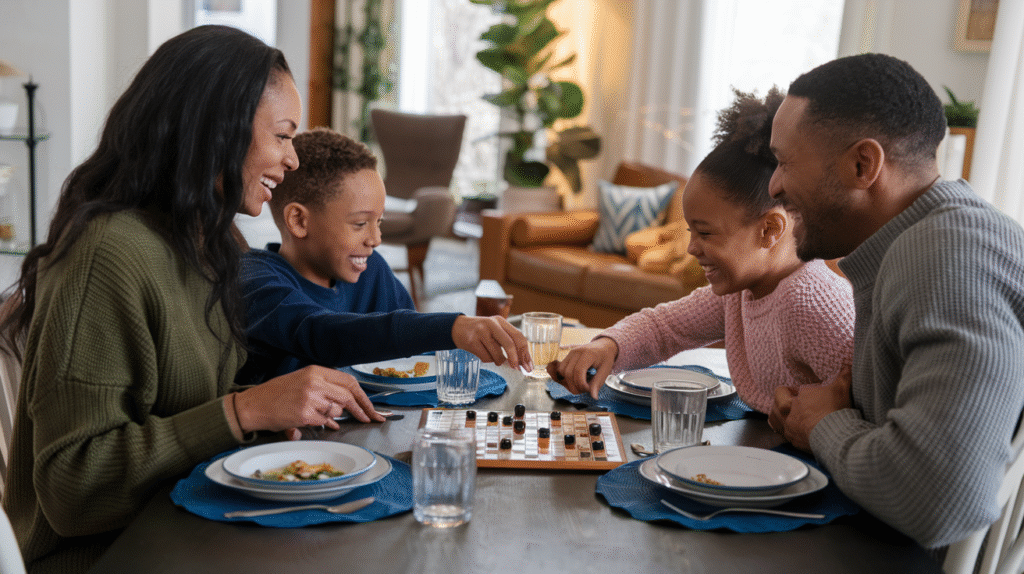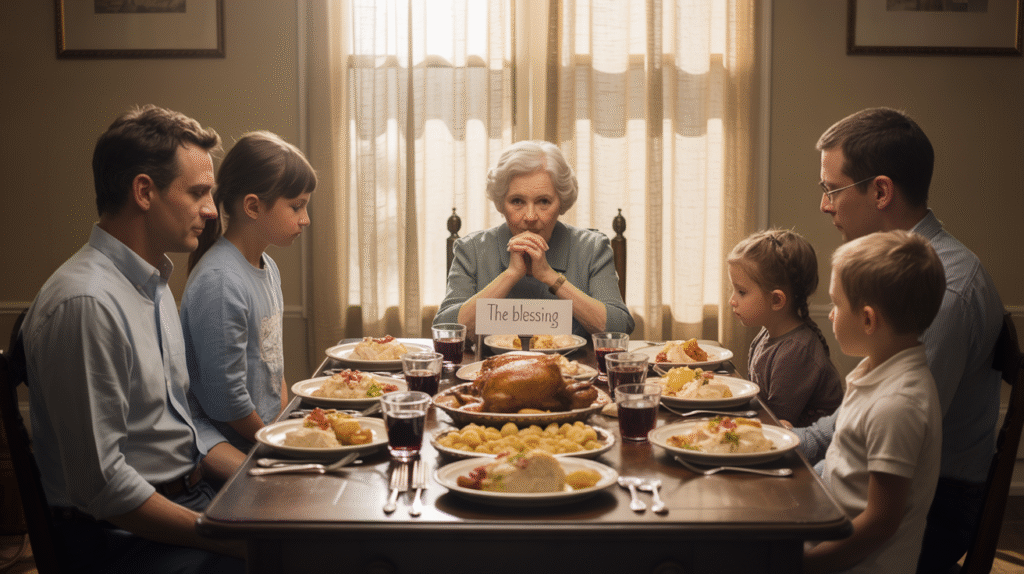
Ever notice how your 10-year-old can name every TikTok dance but can’t recall the story of how grandma and grandpa met? That’s not just a random observation – it’s happening in millions of homes right now.
Family traditions are disappearing faster than dial-up internet, replaced by individual screens and personalized content algorithms that know us better than our own relatives.
But here’s the thing about preserving family traditions in the digital age – it doesn’t have to be an either/or situation. The families who thrive today are the ones who use technology to enhance their traditions, not replace them.
What if I told you the most connected families have found a secret balance that most of us are completely missing?
The Diminishing Connection in a Digital World

A. How screen time affects family bonding
Remember when dinner conversations weren’t interrupted by notification pings? The harsh reality is that screens have created invisible walls between family members sitting in the same room.
When everyone’s eyes are glued to different devices, genuine connection withers. Kids no longer notice parents’ subtle emotional cues. Parents miss their children’s unspoken requests for attention. The neural pathways that develop through eye contact, facial expressions, and physical touch literally cannot form properly when screens dominate family time.
A recent study found that families who use devices during meals experience 73% less conversation and 38% less eye contact. That’s not just statistics – that’s missed opportunities to really know your loved ones.
B. The isolation paradox of social media
Isn’t it ironic? The tools designed to connect us often leave us feeling more alone than ever.
Kids might have 500+ followers but struggle to have meaningful conversations with their siblings across the dinner table. Parents scroll through vacation photos of acquaintances while missing the chance to plan their own family adventures.
Social media has created this bizarre situation where we’re simultaneously overconnected digitally and underconnected emotionally. We know what a distant friend ate for lunch but can’t recall the last time we played a board game with our kids without someone checking their phone.
C. Statistics on family time lost to digital devices
The numbers tell a sobering story:
- Average American family spends just 37 minutes of quality time together daily
- Parents check phones 70+ times during family leisure time
- 58% of teens report feeling disconnected from family due to device use
- 72% of families report device-related arguments weekly
Behind these stats are countless missed moments – bedtime stories never read, backyard games never played, and conversations never had. Every notification we respond to is a tiny choice against presence.
Core Benefits of Family Traditions

A. Creating lasting memories beyond the digital footprint
Remember that trip to the lake when your phone died and you actually had to talk to your family for three hours? Wasn’t it surprisingly awesome?
In a world where memories are measured in gigabytes, family traditions create something far more valuable: experiences that stick with us forever. Unlike social media posts that disappear in the endless scroll, traditions like holiday cookie baking or summer camping trips become the stories we tell for decades.
These shared experiences form the backbone of your family’s unique story. They’re the things your kids will tell their kids about – not how many likes their childhood photos got.
B. Building identity and belonging in children
Kids today are bombarded with messages about who they should be. Family traditions cut through that noise.
When a child participates in something that “our family always does,” they gain a powerful sense of who they are and where they belong. Whether it’s your special pancake recipe on Sundays or your annual neighborhood cleanup day, these rituals tell kids: “This is us. This is what we stand for.”
Research consistently shows that children who feel connected to family traditions demonstrate greater confidence and resilience. They simply know who they are in a world that’s constantly trying to tell them otherwise.
C. Establishing values that transcend technological trends
Apps come and go, but values stick around.
Family traditions subtly communicate what matters most. The holiday volunteer work shows compassion matters. The no-phones-at-dinner rule shows conversation matters. The handmade gift exchange shows thoughtfulness trumps expense.
While technology evolves at breakneck speed, traditions anchor families to timeless principles like generosity, respect, and love. These aren’t just nice ideas – they’re values practiced regularly through meaningful rituals.
D. Strengthening intergenerational relationships
Nothing bridges the generation gap quite like shared traditions.
When grandparents teach grandchildren to fish using the same techniques they taught their own children, something magical happens. Stories flow, wisdom transfers, and suddenly the 70-year age difference doesn’t seem so vast.
These connections provide children with a sense of history and elders with a sense of legacy. For older family members, traditions offer opportunities to remain relevant and valued. For younger ones, they provide perspective and roots in an increasingly rootless digital world.
Modernizing Traditions for Today’s Families

Blending digital elements with traditional practices
Remember how grandma used to mail holiday cards? Now your kids can help design digital versions and send them with a tap. That’s not losing tradition—it’s giving it new wings.
The magic happens when you embrace both worlds. Set up a family video call while baking those same cookies from grandma’s recipe. Snap pictures of your Thanksgiving table and create a digital scrapbook alongside your physical photo albums.
Some families have even created private social media groups where scattered relatives share daily moments, keeping everyone connected between those big holiday gatherings.
Creating new traditions that acknowledge technology
The digital world isn’t going anywhere, so why not make it part of your family story?
Maybe it’s a weekly Zoom game night with cousins across the country. Or perhaps it’s an annual family TikTok challenge during summer reunion.
One family I know creates a collaborative playlist each holiday season—everyone adds songs that defined their year. By Christmas Eve, they have a soundtrack that captures their collective journey.
Using technology to enhance rather than replace gatherings
Technology works best when it brings people physically closer, not keeps them apart.
During family dinners, try using those phones for a shared experience—looking up answers to questions that spark debate, or finding new recipes to try together next time.
When relatives can’t make it in person, set a place at the table with a tablet so they can join virtually. The key is making technology serve your connections, not the other way around.
Practical Traditions That Counter Digital Overload

A. Screen-free rituals that reconnect family members
Remember when we actually looked at each other’s faces instead of screens? Creating intentional screen-free time isn’t just nice—it’s necessary. Try implementing a “sunset shutdown” where all devices go into a basket an hour before bedtime. Or designate entire “tech-free Tuesdays” when everyone unplugs completely.
One family I know created a “conversation jar” filled with questions. During their screen-free evenings, they pull a question and everyone shares. The discussions that emerge? Priceless.
B. Outdoor traditions that promote physical well-being
The great outdoors is the perfect antidote to digital saturation. Start a weekend hiking tradition or a seasonal camping trip. Even simple rituals like evening neighborhood walks after dinner can become meaningful connections.
Many families find that outdoor traditions become the memories kids cherish most. That creek exploration or stargazing session does double duty—it gets bodies moving while creating space for conversations that rarely happen during rushed everyday moments.
C. Creative activities that stimulate different parts of the brain
Our brains crave more than scrolling. Consider a monthly family art night where everyone works on projects together—no skill required! One family rotates who gets to choose the creative activity, from baking to music-making to building.
These activities engage parts of our brains that digital activities simply don’t touch. When your 10-year-old suddenly reveals his thoughts on life while painting, you’ll understand why these traditions matter.
D. Mealtime practices that encourage conversation
Dinner tables should be conversation zones, not device zones. Create rituals around meals—maybe everyone shares their “rose and thorn” (best and worst part of the day) or you play “high-low-buffalo” (something good, something challenging, and something unexpected).
The key is making the table a place where people want to linger. Some families light candles, even for ordinary Tuesday dinners, creating an atmosphere that says “this time matters.”
E. Travel and exploration traditions that broaden perspectives
Nothing breaks digital addiction like seeing the world beyond our screens. Your family travel tradition doesn’t require expensive flights—it might be an annual road trip, seasonal visits to museums, or exploring a new town within driving distance every month.
The magic happens when these adventures become anticipated traditions. Kids grow up understanding that real experiences trump virtual ones. One family designates each child’s birthday month for a special one-on-one trip with a parent—creating individual traditions within the family tradition.
Maintaining Consistency in a Fast-Paced World

A. Scheduling traditions in advance to ensure they happen
In our crazy-busy world, family traditions often get pushed aside for “more important” stuff. But here’s the truth – nothing’s more important than the bonds you’re building with your family.
The key? Put those traditions on the calendar. Seriously. Block out the time for your Sunday pancake breakfast or monthly movie night just like you would a doctor’s appointment.
When our traditions aren’t scheduled, they’re just good intentions that never happen. My family keeps a shared digital calendar where our traditions are marked as recurring events. That cookie baking day in December? It’s there, with a reminder a week before so we can buy ingredients.
B. Adapting traditions during major life transitions
Kids growing up? Moving to a new city? Someone heading off to college? These big changes can threaten your family traditions, but they don’t have to kill them.
The magic happens when you flex a bit. Maybe your holiday cookie day becomes a video call where everyone bakes in their own kitchens. Perhaps that camping trip transforms into an overnight in the backyard when time is tight.
What matters isn’t doing things exactly the same way – it’s preserving the connection that tradition creates.
C. Making traditions non-negotiable family commitments
The most successful family traditions have one thing in common: they’re non-negotiable.
This doesn’t mean being rigid. It means collectively agreeing that these moments matter enough to protect them fiercely. When my kids were growing up, they knew Friday night dinners were sacred – homework got done early, friends came over after, sports were scheduled around it.
By treating traditions as commitments rather than “nice-to-haves,” you send a powerful message about what truly matters in your family’s story.

Family traditions serve as vital anchors in our increasingly digital world, offering connection and meaning when screens threaten to pull us apart. They provide children with stability, strengthen family bonds, create lasting memories, and teach values that technology alone cannot convey. By thoughtfully adapting traditional practices to include modern elements while establishing screen-free rituals, families can create balance in their digital lives.
Start small by implementing one new tradition this month, whether it’s a weekly game night, seasonal celebration, or heritage meal. Remember that consistency matters more than perfection. In a world where digital distractions constantly compete for our attention, intentional family traditions offer something irreplaceable—genuine human connection that withstands technological change and nurtures the relationships that truly matter.




